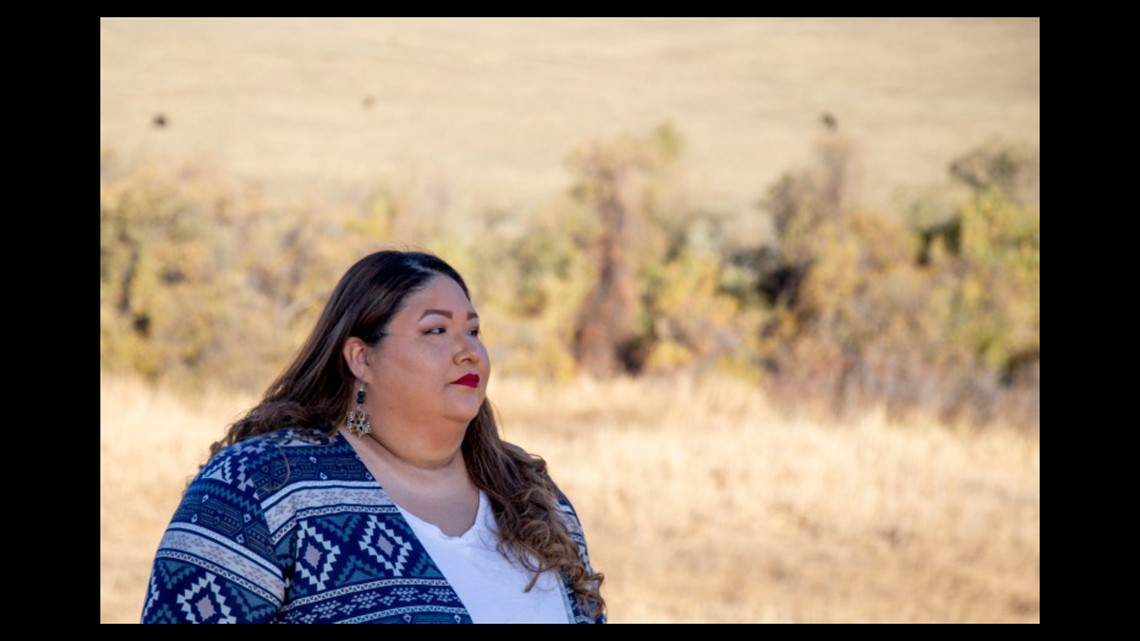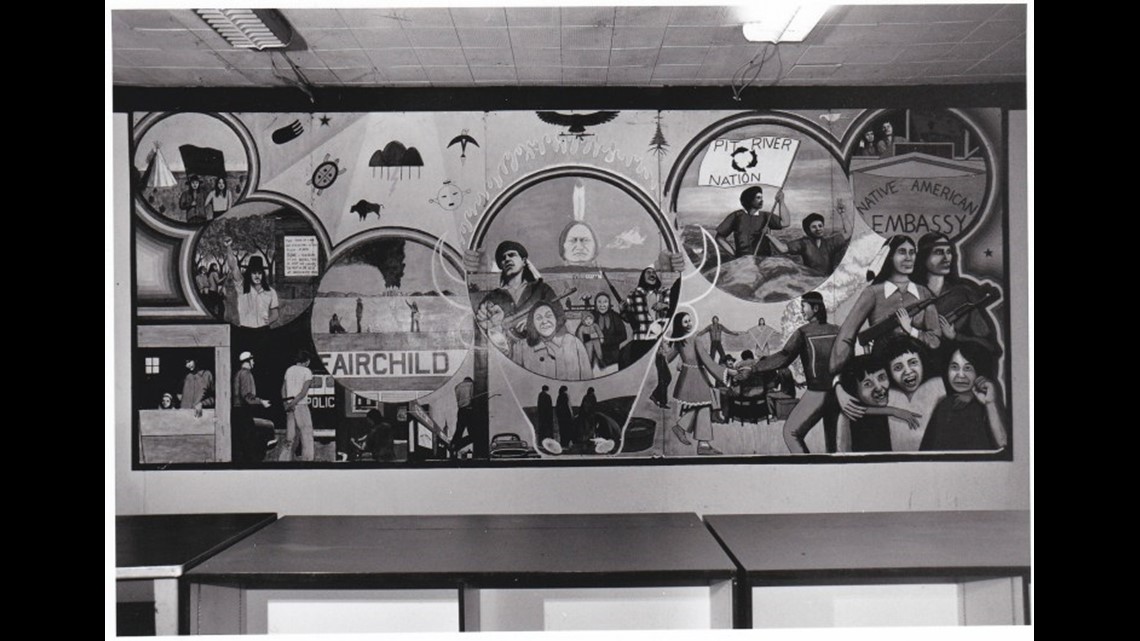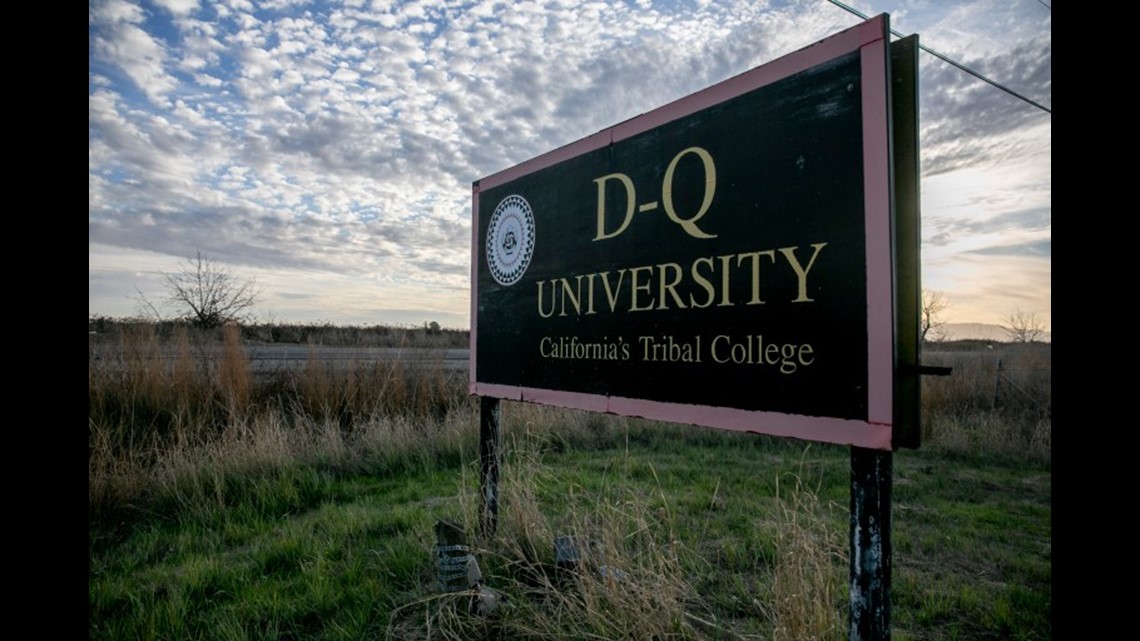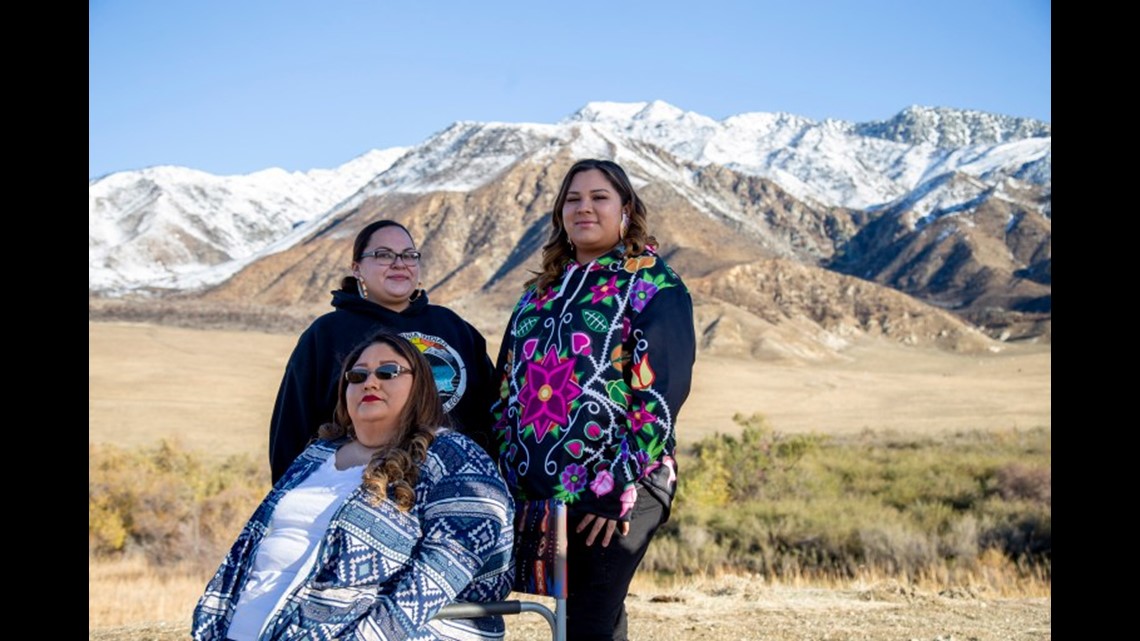Victoria Chubb was supposed to study photography at a college in New Mexico after graduating from high school in Riverside County, but was afraid of being far away from home.
“I really did just chicken out to leave my reservation and to leave California,” said Chubb, a member of the Morongo Band of Mission Indians.
She tried to go back to art school in San Bernadino a few years later, but dropped out to care for her mother, who was ill.
Eighteen years later, Chubb, now 36, is attending a tribal college, the California Indian Nations College, or CINC, in Palm Desert — one of three recently founded in California. She’s thriving there as a liberal arts student and plans to finish an associate’s degree before transferring to a four-year university.


Supporters of California’s new tribal colleges hope they can help more Native American students like Chubb return to higher education — or prevent them from dropping out in the first place.
Native students have the highest high school dropout rate and lowest college-going rate of any racial group in California. Family obligations and feelings of isolation within mainstream colleges are just some of the barriers Native students may have to overcome to access higher education. There’s also a complicated relationship between Native communities and public universities that were built on land stolen from Native people, and lingering trauma traced back to the forced assimilation of Native children in boarding schools — a dark legacy that is only a generation ago for some families.
During the pandemic, enrollment of Native students plunged even more, especially at community colleges, according to the National Student Research Clearinghouse.
Advocates say creating more tribal colleges is one way to offset these trends, and the initial results of the three emerging colleges in California are promising. At CINC in Palm Desert and Kumeyaay Community College in El Cajon, enrollment has remained steady or increased during the pandemic. A third tribal college in Woodland, California Tribal College, will open its doors to students in fall 2021.
“Tribal colleges and universities are different from mainstream colleges and universities,” said Robert Przeklasa, a former chief academic officer at CINC who recently left the college to work for a non-profit. “There is a sense of belonging, a sense of identity, a sense of ease that the students end up feeling.”
That helps boost retention and graduation rates, research has documented. Native students who transfer to a four-year university from a tribal college are more likely to earn a degree, studies have shown. The Center for Community College Engagement found that 88 percent of Native students who attend a tribal college say they feel a sense of belonging on campus. That contrasts with the sense of invisibility and lack of community that Native students — who are more likely than their non-Native peers to be older or parents — often report experiencing at predominantly white institutions.
In Chubb’s family, neither of her parents earned a college degree, but today higher education has become a family affair. Counting on her fingers, Chubb goes through a long list of sisters, cousins and nieces who have followed in her footsteps at CINC.
“I’ve seen a lot of people enrolled that I don’t think would have enrolled in a regular community college,” she said.
There’s a pressing demand for this kind of education in a state where 330,000 Californians belong to a federally recognized tribe, tribal college advocates say.
“There’s a lot of need in California Indian Country for higher education,” said Przeklasa. “I believe that a tribal college is a way to help close those equity gaps.”
Still, new tribal colleges face an uphill battle because of the time and costs associated with accreditation, which they require to award degrees. And the colleges have to raise funds to cover operational costs because there are currently no federal or state higher education dollars available to them.
‘There was a place for me’
American Indians and Alaska Natives account for less than 1% of students in both the University of California and California State University systems, compared with around 1.6% of California’s population, according to the U.S. Census.
The majority of Native students who do go to college in California enroll at community colleges. During the pandemic, Native enrollment across the California community college system declined by more than 22%, according to system officials.
But at CINC, which was created by the Twenty-Nine Palms Band of Mission Indians in partnership with the College of the Desert, student enrollment increased by 10% from 2020 to 2021. Over 180 students from more than 50 tribes have attended the college since it began offering classes in 2018, and CINC held its first commencement ceremony in June to celebrate the first five students who have earned associate’s degrees.
CINC focuses on uplifting students’ identities through culturally relevant classes, such as those in Cahuilla, a language spoken by various tribes throughout the Coachella Valley. That attracts students who might not feel comfortable at mainstream colleges.
“I didn’t ever like school, even though I was good at it,” said Chubb’s cousin Rebecca Waters, also a member of the Morongo Band of Mission Indians. But as a student at CINC, “I love going to college,” she said.
In El Cajon, Kumeyaay Community College began offering an accredited associate’s program through Cuyamaca Community College in 2018.
The college focuses on Kumeyaay language, arts, culture, history and other subjects such as ethnoecology, the study of the relationship between an ecosystem and a group of people.
“We want to reverse erasure, we want to teach our culture and we want to teach our history,” said President Stan Rodriguez, a member of the Kumeyaay Santa Ysabel Band of the Iipay Nation.
In Kumeyaay language courses, students communicate with Kumeyaay speakers from both sides of the U.S.-Mexico border, and — in non-Covid times — travel to Baja California to visit the site of the tribe’s creation story. Out of the approximately 4,600 Kumeyaay people in 16 communities in Southern California and Mexico, only around 41 speak the language, Rodriguez said.


Raymond Martinez, a 20-year old Kumeyaay studies major and a member of the Kumeyaay Santa Ysabel Band of the Iipay Nation in San Diego County, said he studies Kumeyaay to pass the language on to future generations.
“I wanted to learn more about my people and what runs in my bloodline,” he said. “It’s very important for me because that is who I am as a person; it’s my identity.”
Enrollment at Kumeyaay Community College has held roughly steady during the pandemic, with 122 students enrolled in fall 2020 compared to 126 in fall 2019, Rodriguez said.
The difference between a mainstream college and a tribal one was striking for Roseanne Rosenthal, a descendant of the Piro-Manso-Tewa tribe. She always dreamed of going to college. But after her mother died when she was 12, she dropped out of high school.
She eventually earned her GED and started pursuing a double major in psychology and Native American Studies at UC Riverside at age 56. But she also took an ethnic studies class at CINC. There, she saw faculty that looked like her, a rarity for Native students at mainstream colleges. (Native faculty make up less than 1% of instructors at both the University of California and California State University, for example.)
“There was this place for me. I felt like I could at least have a chance here,” Rosenthal said. She’s now finishing a doctoral program in anthropology with a focus in Native American health systems.
Born out of a movement, grounded in Native culture
Tribal colleges are not a new idea in California.
Founded in 1971, Deganawidah-Quetzalcoatl University, California’s first and only accredited tribal college, was one of the first six such colleges in the United States. The university’s name was shortened to D-Q because referring to Deganawidah, the founder of the Iroquois Confederacy, and Quetzalcoatl, an Aztec deity, outside of a ceremonial context, was considered sacrilegious. Born out of the American Indian Movement of the late 1960s, it was an intertribal college, rather than being chartered by a single tribe.
Rodriguez, the president of Kumeyaay Community College, enrolled as a student there in the late 1970s. At the age of 17, he took a Greyhound bus from southern California to Davis.
“I remember I had a duffel bag,” he said. “I was ready to be a student and I walked on this beautiful campus, UC Davis. And I thought that was D-Q University.”
When he realized he was in the wrong place, he flagged down a taxi and asked the driver to take him to D-Q — west of Davis through 10 miles of rolling farmland. They drove up to a campus sprinkled with military buildings, located on the site of a former army telecommunications base.
“I saw this place with all these murals on it, a barbed wire fence around it. And I thought, ‘This place looks like a prison,” Rodriguez said.
Despite the spartan architecture, Rodriguez said his lifelong career as an Indigenous educator was born at D-Q.
“I remember every week, we honored our indigeneity … we honored our elders. And it was also stressed that we need to be able to speak for ourselves. We needed to be able to navigate both worlds, but we needed to be grounded culturally,” he said.
D-Q was not eligible for any federal funding until Congress passed the Tribally Controlled Colleges and Universities Assistance Act in 1978, but even then, the college struggled financially. By 2005, the college lost its accreditation and had to shutter.


Surviving through community college partnerships
There are currently 35 fully accredited tribal colleges and universities, in the United States, most located in the Southwest and the Plains states.
Accreditation can be slow and expensive, because colleges have to foot the bill for site visits and fees, as well as invest in any improvements required by the accreditor. So tribal colleges often partner with mainstream higher education institutions, “borrowing” their ability to award degrees while they work on building capacity and getting the designation themselves, said Cheryl Crazy Bull, a citizen of the Sicangu Lakota tribe and president of the nonprofit American Indian College Fund.
At the same time, it can be challenging to meet both the demands of accrediting agencies and the cultural needs of students, especially before tribal colleges can operate independently. Kumeyaay has been able to develop its own curriculum because its partnership with Cuyamaca has been in place for more than 15 years.
But because it takes years for new courses to be approved, CINC can only offer classes listed in their partner college’s course catalog, said Joshua Cárdenas, the academic coordinator and a history instructor at CINC. Although CINC is working with College of the Desert to develop its own curriculum, at the moment, the history department where Cárdenas teaches only offers one course focused on Native people, he said.
Faculty have had to be creative in response to ensure they are delivering course content that affirms their Native students’ identities. For a course on mass media, they were able to bring in Native guest speakers who work in the media and film industries.
“We really have to do a lot of work right now just to survive in this limbo period,” Cárdenas said.
New tribal colleges face ‘Catch-22’ in funding
While tribal colleges are well-positioned to support Native students, funding for new ones is precarious as Native communities face economic fallout from the pandemic.
Unaccredited tribal colleges aren’t currently eligible for any state or federal educational funding, including COVID-19 relief funds. That includes the $600 million for minority-serving institutions that President Joe Biden recently included in his 2022 education budget proposal.
That means new tribal colleges often have to rely on funding from tribes and other private donations. California Tribal College, for instance, recently received a $50,000 donation from a private donor in Yolo County that will be used to help provide technology to its students, said director Juliet Maestas, an enrolled member of the Hoopa Valley Tribe.
Tribes and reservations in California are also much smaller than many of their counterparts in other states, making it difficult for a single tribe to charter and sponsor a college. During the pandemic, tribal communities have lost revenue from gaming and tourism. At the same time, accreditation is expensive.
“It’s really this Catch-22,” Przeklasa said. “You can’t get any funding until you get accredited, but you need funding to get accredited.”
Even after tribal colleges receive accreditation, they aren’t eligible for federal funding targeted at such colleges unless more than 50% of their students are enrolled in federally recognized tribes.
“When you’re in a more populated area, maintaining that 50% plus one is more challenging,” Crazy Bull, of the American Indian College Fund, said.
In early April, CINC administrators worried they might have to close their doors at the end of the summer after anticipating an 80 percent decline in their operating budget, Przeklasa said.
The Twenty-Nine Palms Band of Mission Indians donated $500,000 to CINC, a fraction of the $3 million needed by fall, and is calling on others to match the investment. At the end of July, the Morongo Band of Mission Indians donated an additional $100,000, and College of the Desert has offered to pay the instructional costs for CINC’s adjuncts for the 2021-2022 academic year.
Even before the pandemic, CINC already operated on a lean budget under $2 million, covering the salaries of eight staff members and supporting 50 students — who don’t pay any tuition because of the college’s accreditation status.
Przeklasa said the investment from Twenty-Nine Palms will help the college stay open in the fall, but long-term funding is required to sustain it.
“It’s going to require sort of a coalition of tribes coming together to fund these efforts,” Przeklasa said.
All three colleges are working together to lobby for federal and state support for new tribal institutions in California, but those efforts are in their infancy. California is a big state, Przeklasa said, and “would require more than one tribal college really to serve the population.”
Chubb, the CINC student, says she plans on using her associate’s degree as a stepping stone to pursue a bachelor’s in museum studies or art history. She currently serves as an executive board member of the Morongo Malki Museum, which is dedicated to preserving the history and culture of Native American communities in southern California.


She continues to encourage other members of her community to take at least one class at CINC.
“That gets their foot in the door, and then they want to take another class and another class,” Chubb said. “And next thing you know, we can have more educated people and come back to the reservation and use these skills that they learned. That’s what I plan to do — use this for the benefit of my people.”



